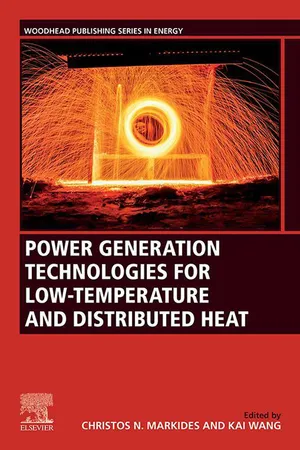
Power Generation Technologies for Low-Temperature and Distributed Heat
- 524 pages
- English
- ePUB (mobile friendly)
- Available on iOS & Android
Power Generation Technologies for Low-Temperature and Distributed Heat
About This Book
Power Generation Technologies for Low-Temperature and Distributed Heat presents a systematic and detailed analysis of a wide range of power generation systems for low-temperature (lower than 700-800°C) and distributed heat recovery applications. Each technology presented is reviewed by a well-known specialist to provide the reader with an accurate, insightful and up-to-date understanding of the latest research and knowledge in the field. Technologies are introduced before the fundamental concepts and theoretical technical and economic aspects are discussed, as well as the practical performance expectations. Cutting-edge technical progress, key applications, markets, as well as emerging and future trends are also provided, presenting a multifaceted and complete view of the most suitable technologies.A chapter on various options for thermal and electrical energy storage is also included with practical examples, making this a valuable resource for engineers, researchers, policymakers and engineering students in the fields of thermal energy, distributed power generation systems and renewable and clean energy technology systems.
- Presents a wide range of power generation technologies based on thermomechanical cycles, membrane technology, thermochemical, thermoelectric, photoelectric and electrochemical effects
- Explains the fundamental concepts and underlying operation principles in each case, and provides theoretical performance expectations and practical technical and economic characteristics
- Reviews the cutting-edge technical progress, key applications, markets, emerging and future trends, and includes practical examples of all technologies
- Details advantages and disadvantages of each technology to allow the reader to make informed decisions of their own for different applications
Frequently asked questions
Information
Table of contents
- Cover image
- Title page
- Table of Contents
- Copyright
- List of contributors
- Preface
- Acknowledgements
- Introduction
- 1. Overview of low-temperature distributed heat and fundamentals
- 2. Rankine cycle and variants
- 3. CO2 cycles
- 4. Oscillatory flow power cycles
- 5. Solid-state devices
- 6. Other technologies
- 7. Thermal energy storage options
- 8. Summary and future outlook
- Index